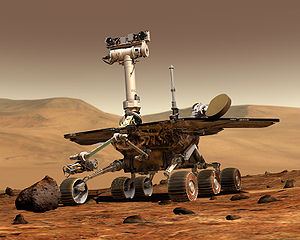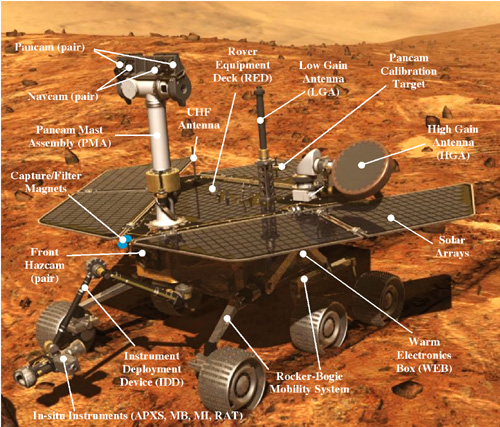
A robot is a virtual or mechanical artificial agent. In practice, it is usually an electro-mechanical system which, by its appearance or movements, conveys a sense that it has intent or agency of its own. The word robot can refer to both physical robots and virtual software agents, but the latter are usually referred to as bots.[1] There is no consensus on which machines qualify as robots, but there is general agreement among experts and the public that robots tend to do some or all of the following: move around, operate a mechanical limb, sense and manipulate their environment, and exhibit intelligent behavior, especially behavior which mimics humans or other animals.
MER-B (Mars Exploration Rover - B), known as Opportunity, is the second of the two rovers of NASA's Mars Exploration Rover Mission. It landed successfully at Meridiani Planum on Mars on January 25, 2004 05:05 Ground UTC (circa 13:15 local time), three weeks after its twin Spirit (MER-A) had landed on the other side of the planet.[1] Its name was chosen through a NASA-sponsored student essay competition. The rover has continued to function effectively over twenty times longer than NASA planners expected, allowing it to perform extensive geological analysis of Martian rocks and planetary surface features; as of February 2009 its mission is ongoing. An archive of updates on its status can be found at the NASA/JPL website
 NASA's twin robot geologists, the Mars Exploration Rovers, launched toward Mars on June 10 and July 7, 2003, in search of answers about the history of water on Mars. They landed on Mars January 3 and January 24 PST, 2004 (January 4 and January 25 UTC, 2004).
The Mars Exploration Rover mission is part of NASA's Mars Exploration Program, a long-term effort of robotic exploration of the red planet.
Primary among the mission's scientific goals is to search for and characterize a wide range of rocks and soils that hold clues to past water activity on Mars. The spacecraft are targeted to sites on opposite sides of Mars that appear to have been affected by liquid water in the past. The landing sites are at Gusev Crater, a possible former lake in a giant impact crater, and Meridiani Planum, where mineral deposits (hematite) suggest Mars had a wet past.
After the airbag-protected landing craft settled onto the surface and opened, the rovers rolled out to take panoramic images. These images give scientists the information they need to select promising geological targets that tell part of the story of water in Mars' past. Then, the rovers drive to those locations to perform on-site scientific investigations.
NASA's twin robot geologists, the Mars Exploration Rovers, launched toward Mars on June 10 and July 7, 2003, in search of answers about the history of water on Mars. They landed on Mars January 3 and January 24 PST, 2004 (January 4 and January 25 UTC, 2004).
The Mars Exploration Rover mission is part of NASA's Mars Exploration Program, a long-term effort of robotic exploration of the red planet.
Primary among the mission's scientific goals is to search for and characterize a wide range of rocks and soils that hold clues to past water activity on Mars. The spacecraft are targeted to sites on opposite sides of Mars that appear to have been affected by liquid water in the past. The landing sites are at Gusev Crater, a possible former lake in a giant impact crater, and Meridiani Planum, where mineral deposits (hematite) suggest Mars had a wet past.
After the airbag-protected landing craft settled onto the surface and opened, the rovers rolled out to take panoramic images. These images give scientists the information they need to select promising geological targets that tell part of the story of water in Mars' past. Then, the rovers drive to those locations to perform on-site scientific investigations.


http://images.google.com/imgres?imgurl=http://www.perspectx.com/store/prodimages/LP0057.jpg&imgrefurl=http://www.perspectx.com/store/proddetail.php%3Fprod%3D0057&usg=__lBcnRswalCp-6GhE8yw-1IItudA=&h=375&w=500&sz=44&hl=en&start=109&um=1&tbnid=M-rZntWwSNB2FM:&tbnh=98&tbnw=130&prev=/images%3Fq%3Dopportunity%2Brovor%26ndsp%3D20%26hl%3Den%26safe%3Dactive%26sa%3DN%26start%3D100%26um%3D1
http://en.wikipedia.org/wiki/Robot
http://marsrovers.nasa.gov/mission/spacecraft_surface_rover.html


 NASA's twin robot geologists, the Mars Exploration Rovers, launched toward Mars on June 10 and July 7, 2003, in search of answers about the history of water on Mars. They landed on Mars January 3 and January 24 PST, 2004 (January 4 and January 25 UTC, 2004).
The Mars Exploration Rover mission is part of NASA's Mars Exploration Program, a long-term effort of robotic exploration of the red planet.
Primary among the mission's scientific goals is to search for and characterize a wide range of rocks and soils that hold clues to past water activity on Mars. The spacecraft are targeted to sites on opposite sides of Mars that appear to have been affected by liquid water in the past. The landing sites are at Gusev Crater, a possible former lake in a giant impact crater, and Meridiani Planum, where mineral deposits (hematite) suggest Mars had a wet past.
After the airbag-protected landing craft settled onto the surface and opened, the rovers rolled out to take panoramic images. These images give scientists the information they need to select promising geological targets that tell part of the story of water in Mars' past. Then, the rovers drive to those locations to perform on-site scientific investigations.
NASA's twin robot geologists, the Mars Exploration Rovers, launched toward Mars on June 10 and July 7, 2003, in search of answers about the history of water on Mars. They landed on Mars January 3 and January 24 PST, 2004 (January 4 and January 25 UTC, 2004).
The Mars Exploration Rover mission is part of NASA's Mars Exploration Program, a long-term effort of robotic exploration of the red planet.
Primary among the mission's scientific goals is to search for and characterize a wide range of rocks and soils that hold clues to past water activity on Mars. The spacecraft are targeted to sites on opposite sides of Mars that appear to have been affected by liquid water in the past. The landing sites are at Gusev Crater, a possible former lake in a giant impact crater, and Meridiani Planum, where mineral deposits (hematite) suggest Mars had a wet past.
After the airbag-protected landing craft settled onto the surface and opened, the rovers rolled out to take panoramic images. These images give scientists the information they need to select promising geological targets that tell part of the story of water in Mars' past. Then, the rovers drive to those locations to perform on-site scientific investigations.

